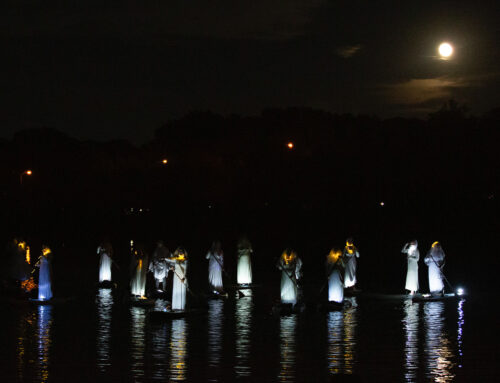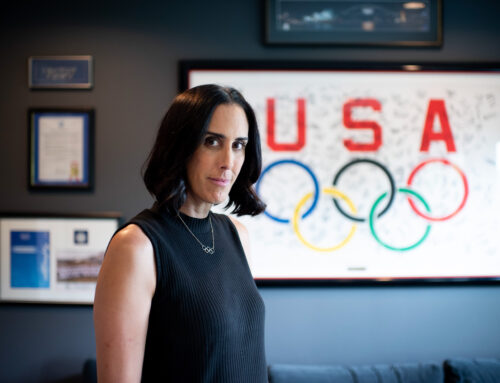When you walk in, it’s all right there — new release CDs, blockbuster DVDs, and New York Times bestsellers in print and audiobook. Down the hall a fire glows, and people lounging in overstuffed chairs around the hearth are thumbing through the latest editions of Newsweek and Real Simple. Across the way, students and business professionals are hunched over their laptops, surfing the Internet while sipping macchiatos purchased from a coffee kiosk.
It’s a scene from a typical mega-bookstore. But if you live in San Jose, Calif., this is actually your neighborhood public library. Libraries like this aren’t simply the wave of the future: They’re already a reality throughout the country, says Susan Hildreth, president of the National Public Library Association. So it’s only natural to assume that Dallas, a city that prides itself on trendsetting, would be in this premier category. All it takes is one step into the Lakewood branch, however, to see that this isn’t the case.
For starters, there’s that musty smell that greets visitors at the door. A plaque on the wall touts the design as a 1970 American Institute of Architects award winner, but the building doesn’t exactly have a retro flair. It just looks, well, old. And that’s just aesthetic. The selection could use some updates as well. A video shelf near the front is heavy on the VHS format, and visitors are more likely to find classic films than recent flicks. A bookshelf stocked with new releases is a nice idea, but its contents are a far cry from the titles on a Barnes and Noble display table.
Yet library folks don’t seem particularly perturbed by this reality.
“The Lakewood library is such a special place because it really has been and continues to be the heart of the community for so many people,” gushes Maryann Kitchens, a former Lakewood librarian who now sits on the branch’s Friends of the Library board. “To me, it’s kind of like the Starbucks. You see more and more people now congregating together for coffee and conversations.”
Except that the Lakewood branch location doesn’t resemble Starbucks in the least, the absence of Frappuccino being just one major distinction. When pressed, Kitchens says she means only that the library is a community hub, an idea often echoed by other library folks.
It’s a noble thought, the library being the center of neighborhood activity, but it’s mostly wishful thinking. Even people who frequent the Lakewood library don’t see it that way.
“It’s a place where you can find books, not really a place to hang out or be really active in the community,” says neighborhood resident Becky Bronson, putting down the magazine she was perusing. “Half-Price Books has a coffee shop, and that’s probably a place you browse for longer, more of a relaxed café atmosphere.”
So why don’t neighborhood residents — even the ones who use the libraries regularly — see them as neighborhood hubs?
Part of the answer — as with most things involving city government — is money. Over the last five budget cycles, the library’s piece of the general fund pie has remained the same — roughly 2.8 percent — despite the fact that four new branch libraries will have opened before the end of fiscal year 2007. Despite this, Dallas Public Library director Laurie Evans doesn’t consider her department to be treading water. She believes the libraries are “well-positioned” and “sit very comfortably in terms of our budget.”
But just last year after she was hired, Evans told a Dallas Morning News reporter that the library was “at bare bones in terms of service and what we can provide.” Evans says the quote was taken out of context: She wasn’t referring to the article’s mention of preliminary city budget numbers showing that $880,000 would have to be cut from the library’s coffers. Instead, Evans says, she was arguing that you can’t throw money at materials without providing funds for extra staff members to process and shelve those materials. Yet in the same breath, Evans says she doesn’t see a need for hiring additional librarians or expanding materials.
“I’m not asking for more. I’m pleased with where we’re headed,” she says.
Though many probably wouldn’t admit it, that can’t be music to the ears of library employees who often rely on “Friends” groups — neighborhood residents who raise money for their local branch — for basic needs such as trash cans, book carts and hand soap. If this is the reality, then it’s clear our branches could use some help. But if the people driving our libraries are perfectly satisfied with the status quo, will we ever get to San Jose?
We haven’t always lagged behind the curve. In the ’70s, Dallas was among the vanguard of the nation’s libraries, says Michael V. Hazel, who chronicled the library’s first 100 years in his book, The Dallas Public Library: Celebrating a Century of Service 1901-2001. Its branch circulations were among the highest in the country, and the system was the first in the United States to launch a computerized catalogue. But the economic downturn of the late ’80s and ’90s slashed millions of dollars from the library’s budget, crippling its ability to keep up with the latest trends, let alone set them.
“I think it takes a long time to recover from that,” says Lakewood resident June Leftwich, who became a library employee in 1973 and now serves as the Dallas Public Library board’s vice-chair. Even at the turn of the century, when Hazel was completing his book, librarians were anxious that the city might impose further cost-cutting measures, but Hazel’s sense is that dollars have remained fairly stable since then. “That certainly doesn’t mean they have all the money they need to operate,” he says.
That’s not what you might expect for the second largest municipal library system in the nation. And, in fact, Dallas even lags behind other Texas library systems. Take, for instance, Houston’s Harris County Public Libraries, the system with the highest circulation rate in the state. Five years ago, director Catherine Park and her staff began referring to library patrons as “customers” and stocking shelves at each branch with bestsellers, popular children’s books and new release DVDs. Harris County also turns over its collection at the highest rate in the state (Dallas has the lowest), and therefore has endured some criticism from the hey-that-book-wasn’t-worn-out-yet camp.
“We just don’t have the space to never throw them away,” Park says. “That’s part of our high circulation. You don’t keep old and worn things on the shelf because they distract from the relevant collection.”
Today’s libraries find they have to cater to two major groups; the first being people who solely want quick and easy access to library materials. In Harris County, cardholders can simply request an item through the library’s website, walk in and grab it off a hold shelf, and scan it at one of the self-checkout counters. These amenities benefit librarians, too; they can spend their time focusing on branch development instead of scanning books. But another segment of the population wants libraries to serve as social venues, and to that end, Harris County’s branches are inviting people to hang out by adopting the Barnes and Noble-esque trend of cushy chairs and, yes, even cafés.
Park, herself a 26-year veteran, says inviting food and drinks into the libraries was the toughest change for her staff to get over, but it’s part of what has contributed to their now “bustling” atmosphere.
Many of the ideas implemented over the last five years were borrowed from San Jose, which is comparable in size to both Harris County and Dallas. Park says she was impressed with San Jose’s high usage numbers; the branch library described at the beginning of this story had a circulation of 87,000 last July (compared to Lakewood’s monthly circulation, which averaged 22,500 last year).
“We’re not afraid to do pilot projects and see how customers respond,” Park says. “We have to do that to continue to make the library a vital place in the community.”
So what needs to change about Dallas’s libraries in order to keep them relevant? It’s a subject Evans is reluctant to discuss. She prefers to refer to them as one of the city’s “best-kept secrets,” believing that if she and her staff can get people in the door once, they’ll return. But she admits the libraries need some updates. Her current pet project is turning downtown’s Central library into an “urban center” with a downstairs café, a gallery space for local artists, and wireless headsets that allow librarians to move freely among aisles of books instead of being chained to a desk — all of which should become reality within a year, Evans says.
Nothing similar is proposed for the branches, except for perhaps the wireless headsets. But, to their credit, neighborhood librarians are doing what they can to keep pace with changing times. Like the monthly come-and-go art activity Lakewood children’s librarian Suzie Riddle created in an attempt cater to families’ hectic schedules. Or the e-mail list Skillman Southwestern children’s librarian Cindy Oser is compiling to spread the word about activities. And free WiFi has been offered for months at quite a few branches, including Riddle’s and Oser’s.
“We get a lot of people in here who don’t even own a computer, and now we’ll get more college students and businesspeople who have some time to regroup during the day and might want to stop by a library,” she says. “I think we’re catching up with other cities by providing that.”
But it will take more than WiFi to catch up, and that won’t happen if all Dallas librarians can rely on is the generosity of their local Friends board. Though Riddle was quick to say that Lakewood is “very well taken care of,” she says if the city were offering, she wouldn’t turn the money down. “If somebody won the lottery and walked over and handed me their check, I’d start knocking down the walls and build a whole second floor for the grownups so the kids could just have the first floor to ourselves,” Riddle says.
Evans acknowledges she wouldn’t turn down money, either, though she makes clear she’s not asking for a padded budget. But “in a perfect world,” she admits she would like to modernize buildings at least every 20 years, stock the branches with bestsellers that are flying off the shelves like hotcakes, install the latest technology sooner rather than later, and hire more staff to implement all of this. “We’d phase in things faster at some of our older locations. We wouldn’t be as tied to or dependent on passage of the bond to do things we want to do long-term,” Evans says.
That said, the most recent bond election gave her hope that Dallas residents are rallying behind the libraries. In 2003, voters approved $55 million to build four new branches and replace four others, the largest proposition in the history of Dallas libraries and the highest vote-getter on the ballot. Rodney Schlosser, chair of the Dallas library board, cites this as proof the city may be on the verge of moving its branch libraries into the 21st century.
“If we continue to invest at the pace we’ve been investing since the beginning of this decade, then Dallas opportunity is really unlimited,” Schlosser says. “We are on the right trajectory now, and we have momentum.”
Evans points to the recently opened Hampton-Illinois branch in Oak Cliff, a library attached to an elementary school, as an example of the innovation these bond dollars can accomplish.
Dallas isn’t alone in the joint library-school concept, she says, but “we’re few and far between.” The same goes for the small community theaters added to this location and three other new and renovated branches. Though Dallas isn’t one of the premier systems in the country now, “I like to think that we’re turning the corner to get there,” Evans says.
It may take a sprint to get up to speed with other systems. Hazel cites Denver in his book as a city that underwent a similar economic downturn, yet never reduced its library budgets, and even passed a $90 million bond proposition in 1990. Today, Denver’s cutting edge practices include audiobooks, movies and library podcasts that can be downloaded from its website.
Passage of the $46 million library proposition on Dallas’s Nov. 7 bond election would be a step in the right direction. It includes $8 million for a new White Rock branch, but lacks modern amenities for our existing branches, though Lakewood would receive a new parking lot, roof and HVAC system. Schlosser admits that even with this funding, there would still be gaps (the library’s original recommendation was closer to $74 million), but it would help reverse the recession of the previous two decades.
That may be a small miracle in a state that ranks 40th in the percentage of income it provides to libraries, or, as Hazel says, in a city that has always prided itself on keeping taxes low.
“As a result, there never was quite enough money to go around. The library was one of the departments that suffered as a result,” he says.
Another department that took a substantial hit after the economic downturn was the parks, but concerned citizens across the city have banded together over the last few years to get budget dollars up and hundreds of millions in bond dollars passed, not to mention a $348 million proposition on this month’s ballot. Park activists are calling it a renaissance. Will libraries be next? It’s a question that persuades Evans to break from toeing the eternal optimist line, even if just for a moment.
“Oh goodness, I hope so,” she exhales.





